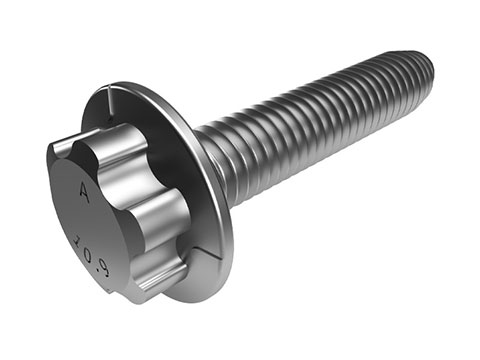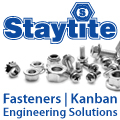
Posted to News on 24th Feb 2025, 12:40
Thread grooves with the highest requirements
Space is at a premium in many automotive applications. As a result, less and less installation space is available for bolted connections. At the same time, however, the requirements for preload forces and the reliability of the connections are increasing. And the lowest possible overall connection costs are also important. A new thread-forming screw for direct metal fastening has been developed by ARNOLD UMFORMTECHNIK to meet precisely these challenges.

With light metal screw connections, the focus is on optimising installation space, performance compression and cost optimisation. A very important point against this background is the load-bearing capacity optimisation of the connection. With regard to thread-grooving metal screw connections or light metal screw connections, this means that better utilisation of the nut material must be achieved through a higher thread overlap of the thread flanks of the screw and grooved nut thread.
It is precisely for these applications that ARNOLD UMFORMTECHNIK has developed Powertite. "The thread-grooving Powertite is characterised by a higher load-bearing capacity of the screw itself compared to conventional products on the market. Thanks to a slightly increased stress cross-section, which corresponds to the level of the standardised stress cross-section of a metric screw, the Powertite can generate higher tensile breaking forces," says Thomas Jakob, Application Sales Engineer at ARNOLD UMFORMTECHNIK.
Thanks to the special geometry of the fastener, relatively high assembly preload forces can be achieved during screw assembly in conjunction with adapted surface systems. These are generally on a par with metric screws, both for elastic and overelastic assembly.
The Powertite screw is a round thread-forming screw with a trilobular forming zone. This means that where the forming work is carried out, the screw has a slightly triangular cross-section (with rounded corners) to reduce the forming torque. The forming zone length is optimized with a length of 3 x p (p = thread pitch) installation space and enables the forming work to be distributed over several threads during the thread forming process as well as optimum positioning and centring of the screw.
The round load-bearing cross-section has a defined oversize; the outer diameter of the screw is always larger than the nominal dimension. This ensures greater overlap between the thread flanks of the screw and the grooved nut thread.
Basically, this special geometry ensures that the screw achieves a higher stress cross-section and therefore slightly higher tensile breaking forces than conventional metric screws. The combination of trilobular cross-section in the grooving zone and round cross-section in the load-bearing area significantly optimises thread-grooving screw connections because, on the one hand, the grooving torques are low and, on the other hand, the overtorques and load-bearing capacity of the grooved nut thread are significantly increased.
Areas of application for self-tapping screws
With Powertite, ARNOLD UMFORMTECHNIK aims to provide an answer to the new market requirements: transferring higher assembly preload forces in less installation space. There are numerous examples of the use of thread-forming Powertite. These include applications in which the highest preload forces have to be achieved through over-elastic assembly. It is also suitable for assemblies where only a small screw-in depth can be realized and high hole tolerances are required.
In many cases, a weight reduction can also be achieved by reducing screw lengths and weight-optimised screw heads.
Compared to other thread-forming screws, Powertite is a newly developed load-bearing capacity-optimised thread-forming screw. While the entire load-bearing and thread-forming area of Taptite is trilobular, Powertite is round with oversize in the load-bearing area and trilobular only in the thread-forming area. As a result, the preload force level of metric screws was achieved even with overloaded assembly and installation space optimization was also possible. In both cases, the Fast Designer Metals tool can be used to make a mathematical prediction for the specific application. This is always preceded by a recommendation from ARNOLD UMFORMTECHNIK for a suitable core hole design.
Diverse optimisation and savings potential
The focus of Powertite applications is on electromobility in particular. It offers great potential, from the battery area to the engine and axle steering area as well as the transmission. This applies in particular to light metal screw connections, but also in combination with cast components.
Thomas Jakob has been familiar with precisely these topics through his work in various areas for many years. Market proximity is very important to him: knowing the interface to the customer, advising with a view to the specific application and driving product development forward together with the customer.
He cites three examples in which assemblies were optimised through the use of Powertite thanks to targeted advice and extensive calculations and investigations: "In a gearbox housing screw connection, an M8 thread-forming screw, which was originally mounted elastically, was replaced by a Powertite M7, which is mounted overelastically. This enabled significant downsizing to be achieved. In a high-voltage battery application, the use of Powertite M8 x 33 for bracket bolting in cast and drilled hole areas resulted in significant cost savings compared to the metric bolts previously used.
"An actuator screw connection in the steering column has also become more cost-effective thanks to the use of a Powertite M6 x 20. Previously, a metric screw was screwed into a press-in nut. By eliminating the press-in nut, there are now no costs for the element and the setting process."
Calculation of weight and CO2 savings
Powertite thread-forming is a fundamental further development of thread-forming technology. By replacing conventional M8x40 thread-rolling screws (nominal diameter x length) with M7x40 screws from the Powertite series, significant CO2 savings can be achieved. This is demonstrated by two specific examples.
Since June 2022, the Powertite M7x40 has been used in a load transfer gearbox, which is currently still used in conjunction with a combustion engine. This alone can achieve a weight saving of around 42 g per gearbox and therefore a CO2 saving of around 72 g per gearbox. With 13 screws per gearbox and a requirement of around 6 million screws per year, this results in a weight saving of around 19,400 kg or a CO2 reduction of 33.1 tons per year for this gearbox alone.
The savings are even greater for an electric motor gearbox unit, in which 33 screws are used per gearbox unit. Of the 50,000 vehicles planned per year, 30,000 are expected to be equipped with two e-motor transmission units per car. In this case, the weight saving through the use of Powertite is around 213 g per vehicle and the CO2 saving is around 364 g. Extrapolated to all 50,000 vehicles and the 80,000 gearboxes required, this results in a total requirement of around 2.64 million screws per year. The use of Powertite alone can then achieve a weight saving of around 8,519 kg or a CO2 reduction of 33.1 tons per year in the production of these vehicles. This means a CO2 saving of 17 percent per vehicle for the fasteners replaced by Powertite.
Technical and commercial advantages
With the thread-rolling Powertite, the load-bearing capacity of the grooved nut thread is increased by more than 20 percent compared to standard trilobular screws. This means a number of technical advantages. These are: standard-compliant thread forming torques, over-elastic assembly even in conically cast core holes in GD-Al, a preload force level similar to metric screw connections and the possibility of larger core hole tolerances to optimize casting processes for light metals. In addition, there is a high level of assembly reliability and applicability in steel, aluminium and other light metals.
Furthermore, hollow bolting is possible and can be replaced by metric bolts when servicing is required.
In addition to the technical advantages, Powertite screws offer a number of commercial benefits: a reduction in overall fastening costs of up to 85%, the possibility of downsizing, space and weight optimisation and leaner upstream processes in the production of light metal or steel components.





